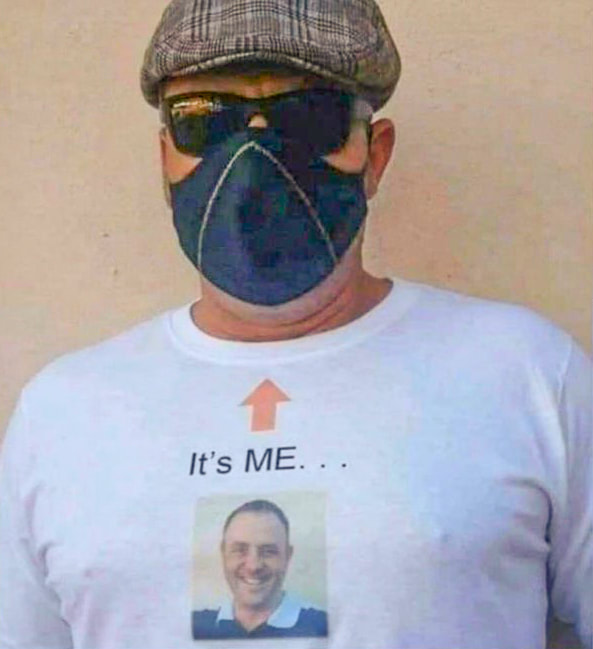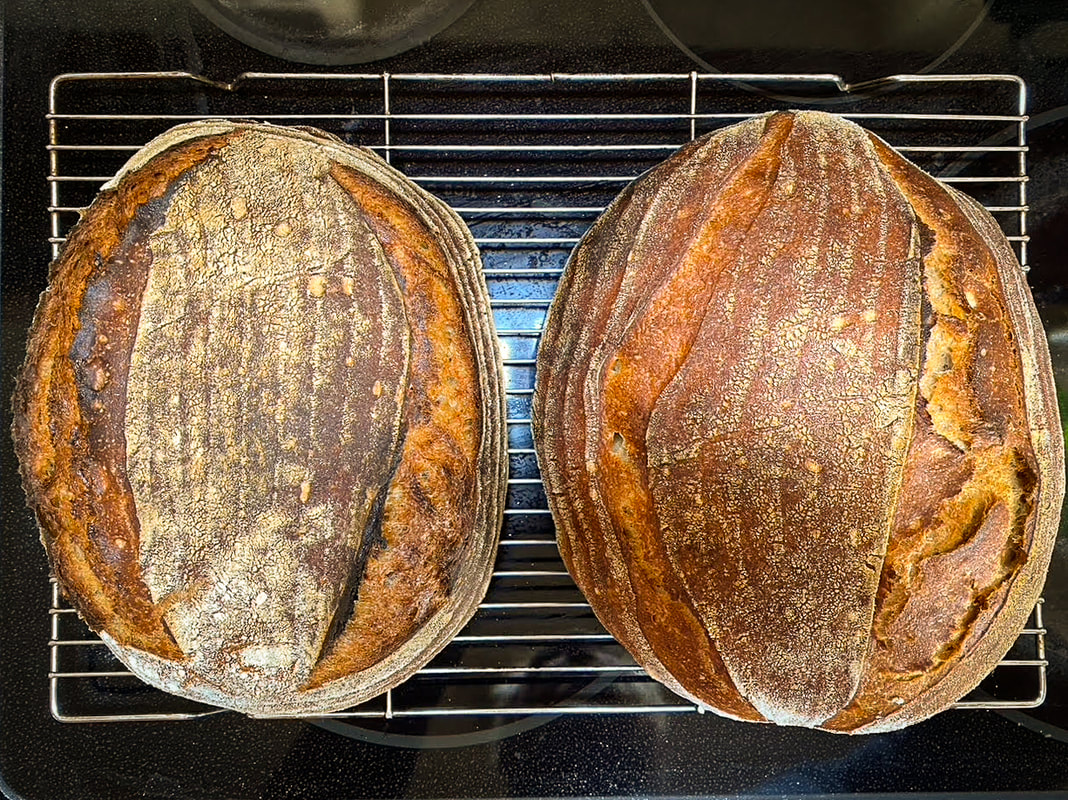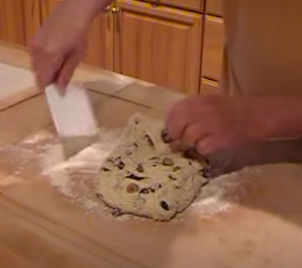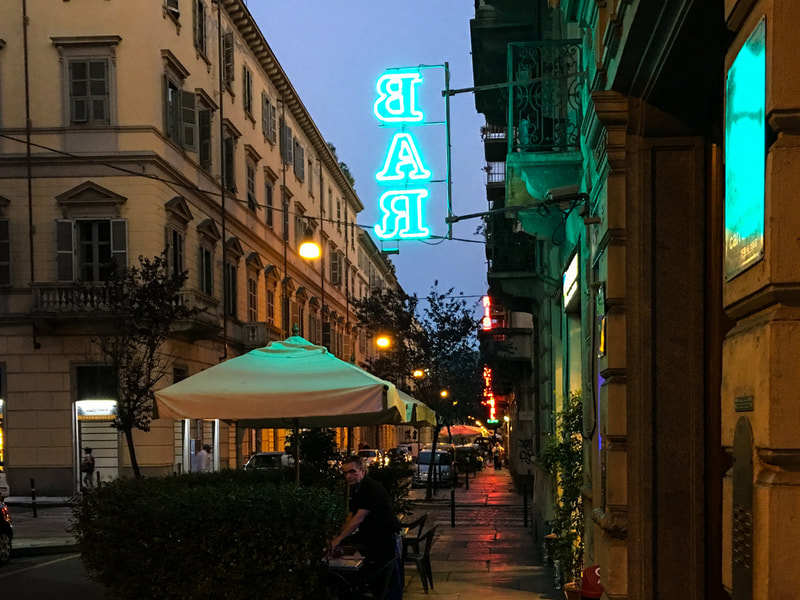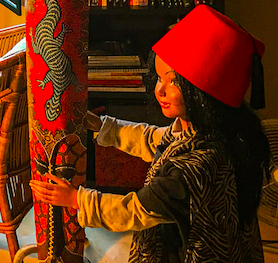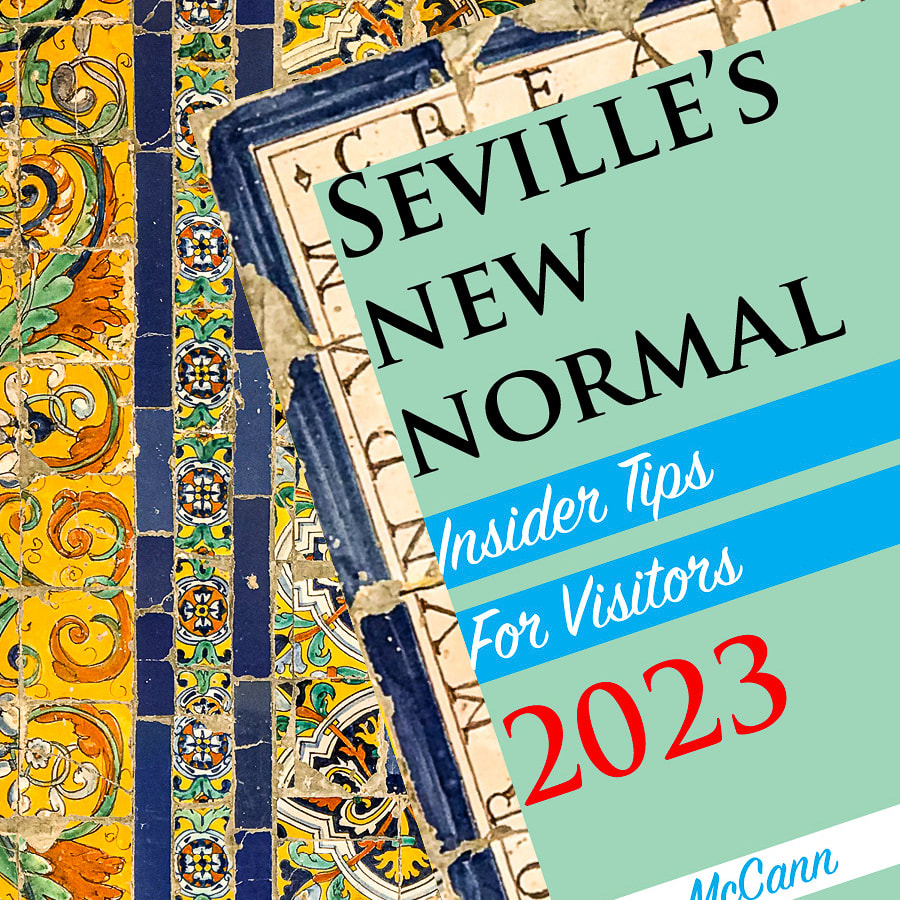|
For inspired lunacy, it’s hard to beat the idea of a pandemic mask printed with the lower half of your very own face. We’ve spent months feeling stripped of our visual identity by surgical masks and struggling to express our personalities through face coverings of cheery print fabrics or don’t-mess-with-me dark solids; is now the time to show the world who we really are? Maskalike is hoping to launch their line of personal face masks soon. In the meantime, how about a t-shirt that shows what you looked like back in the days when we all went around barefaced? During the early months of the pandemic, underemployed creative types kept busy posting memes and song videos we could all enjoy for free. Now they’re designing and marketing products that let them express the same humor and existential angst, only now they’re hoping to make a few dollars by turning them into saleable items like t-shirts and mugs. A quick scroll through Etsy, an online marketplace for cottage industries, reveals a wealth of wit and wisdom. Chuckling over a clever t-shirt is just one small way to lighten these dark times and help us maintain a grip, however tenuous, on our sanity. I recently received an article from my medical provider titled, “Is the coronavirus pandemic affecting your mental health?” (Is it paranoid to wonder if they sent this to everybody or just me?) The story linked to a podcast about the symptoms that could indicate you need psychiatric help, including:
Let’s face it, if you’re not experiencing at least some of those symptoms, you haven’t been paying attention lately. Just this morning I heard on the radio that California’s numbers took an uptick of worrying proportions: 42,000 new COVID-19 cases in the last two weeks, representing 25% of the state’s total cases so far. It’s hard to match up those figures with the “let the good times roll” atmosphere I’m seeing around me. Our little town of San Anselmo has started closing the main thoroughfare on weekends to allow café tables to spill out into the street. Friends gather there in clusters to enjoy the fine weather, great food, famous Napa wines, and the opportunity to exchange droplets without any of those pesky masks getting in the way. The virus, said this morning’s radio announcer, is no longer focused on institutions such as nursing homes and prisons; it’s jumped to households. To me, all this rampant unprotected mingling seems like an open invitation for the coronavirus to spread throughout my community and keep killing us for years. Walking past the crowded picnic benches and café tables in downtown San Anselmo, I began experiencing low mood, loss of appetite, lack of joy, racing heart, shortness of breath, and considerable irritability. In fact, I found myself scowling so fiercely at a barefaced woman walking by that she hurriedly pulled her bandana up over her nose and mouth and increased her speed to get away from me. “Oh my God, Rich,” I said. “I’m turning into the town curmudgeon.” People keep saying, “It’s time to start living normally.” If only! There seems to be a widespread belief that the pandemic is all over but the shouting, and that the government wouldn’t let us reopen businesses and hold public gatherings if it wasn’t safe. Do I really need to provide a list of the things the government lets us do that have proven, time and again, to be extremely bad ideas? For obvious starters, there’s binging on cheap alcohol, having sex with inappropriate strangers, and smoking cigarettes and/or excessive amounts of marijuana. And then there's all the risky business with science and technology. Didn’t we learn anything from Frankenstein? Or Jurassic Park? Or FindFace, the new Russian app that’s apparently designed for stalkers? “If you find yourself in a café with an attractive girl, and you don’t have the guts to approach her, no problem,” says the ad, which was showcased on a program about the dangers of facial recognition software. “All you need is a smartphone and the application FindFace Find New Friends. Take a picture and wait for the result. Now you’re already looking at her profile page.” Could that be any creepier? As far as I know, FindFace is only available in Russia, which kind of makes you want to scratch Moscow off your travel itinerary, doesn’t it? You won’t be heading there soon in any case; Russia is one of many countries that haven’t yet unsealed their borders. The EU is slowly opening up to international travel, but so far they’re planning to keep Americans out due to concern over our nation’s infection rate. Before considering any trip abroad, see comments above re: things you may be able to do but probably shouldn’t. And then read about the perils and aggravation of My Harrowing Pandemic Journey from Seville to SF. If you’re still determined to go, here’s the latest info on what, when, and how countries, airlines, and hotel chains are reopening around the world. If you’re wisely refraining from international travel, don’t worry, you can still pick up exotic souvenirs to wow your friends. Alabama-based Unclaimed Baggage is the nation’s only retailer selling the contents of suitcases left behind at airports for more than three months. And while most of the contents are just as boring as you’d imagine, and wind up going to charity or the recycling center, there have been many extraordinary finds. Over the years, staff members have unearthed an Egyptian burial mask, a camera from the space shuttle, a Tibetan ceremonial horn, Chinese opium scales, an entire bear pelt packed in salt, and one live and rather bewildered rattlesnake — which was not offered for resale but given away to a good home. People everywhere are adapting to the strange new rules we live by. This week Barcelona’s opera house, the Gran Teatre del Liceu, held a performance, billed as a prelude to its 2020-2021 season, in which a string quartet played to a capacity audience composed of 2,292 plants donated by local nurseries. The leafy crowd seemed to enjoy Puccini's Crisantemi, which was also livestreamed to humans. After the show, the plants were gifted to health care professionals who work at the Hospital Clínic of Barcelona. Despite all the shocks and changes, our world remains a wild and wonderful kaleidoscope of human creativity. There’s plenty of inspired lunacy to keep us thinking and chuckling as we learn to navigate our crazy new normality and find ways to stay safe while living fully and joyfully. On good days, I believe this first round of the pandemic will finally subside, and we’ll somehow avoid a second wave in October. It’s up to all of us to do what we can to make that happen. I’m thinking of buying this t-shirt in case anyone needs a reminder. Unlike some of my better-organized and more practical blogger friends, I don't accept sponsorships or do promotions; the links shown here are to resources I enjoyed so much I thought you'd get a kick out of seeing them, too. YOU MIGHT ALSO ENJOY Don't miss a single post! Send me your email address and I'll alert you when the next one is out.
4 Comments
"If you're going through hell, keep going." Winston Churchill I’m not much of a spelunker, but some years ago, I found myself deep underground on a private “wild tour” of West Virginia’s Organ Cave,. “How long does the tour take?” I’d asked at the outset. “Five hours.” “Sorry, we only have three; we need to get back for a business dinner.” “OK, we’ll do it in three,” said the guide, bounding like a mountain goat down the rocks. Scrambling after him through the winding caverns, our only light the headlamps on our miner’s hats, Rich and I eventually reached a vast cavern with a row of stalactites that could, if you squinted just right, be said to look like a pipe organ. We had about thirty seconds to gawp at its magnificence and then we were racing back. I was doing all this in old, slippery sneakers and was frankly feeling pretty proud of how well I was managing until halfway back, when I ran into trouble. I’d dropped a little behind while navigating slender footholds on either side of a narrow crevasse. The gap kept getting wider and the space for my feet narrower until I ran out of footholds. I flashed my headlamp wildly around, seeking any way forward; nope, I was well and truly stuck. I called out and the guide sprinted back to help. “Look again,” he said and shone his headlamp over the rim of the crevasse. There, below the edge, were abundant outcroppings of rock and packed earth, offering easy footing all along the way. I’ve thought of that moment a thousand times in the years since, most often when I’m trying not to panic over something — like this week’s Washington Post piece “The coronavirus pandemic isn’t ending, it’s surging.” While some countries, such as New Zealand and Taiwan, have eradicated the virus, the US is still in deep trouble, with death tolls predicted to reach 200,000 by October. The optimism, or economic desperation, that fueled the reopening is giving way to gloom. “As the long, hot summer of 2020 begins,” said an article in The Atlantic, “the facts suggest that the U.S. is not going to beat the coronavirus. Collectively, we slowly seem to be giving up.” I can’t speak for all of America, but around here the attitude isn’t so much despair as discombobulation. Official information is skimpy, advice conflicting, directives vague. “The administration’s guidelines for ‘opening up America again’ are so bereft of operational specifics that they’re like a cake recipe that simply reads, “Make cake,” wrote Ed Yong in The Atlantic. We’re all stumbling in the dark. “As things change the uncertain feelings seem to stay the same,” my friend Kitty wrote in a comment on my post last week. “What should I do or not do?” Kitty, the only thing I can tell you for sure is that we should all start planning for the long haul. Experts predict the pandemic could easily hold us in its grip for two years. Let’s hope they’re not being as overly optimistic as the Spanish officials who told us in March that lockdown would last two weeks. Whatever the timeframe turns out to be, it behooves us all to take a deep breath, stop talking about “when all this is over,” and start figuring out how we’re going to live the best lives we can now, in the shadow of COVID-19. How? According to positive psychology, there are five key elements of a happy life:
“Bread baking has become an empowering and meditative act,” wrote Katharine Gammon in the Guardian article “Kneeding to relax? How coronavirus prompted a surge in stress baking.” I started baking in earnest a few days after the start of lockdown, when our last loaf was gone and I wanted to dissuade Rich from risking his life venturing out in search of an open panadería. Being lazy and lacking yeast, I sought out an Irish soda bread recipe, finding one with such good texture and flavor it’s become a mainstay. My friend Phil has spent the pandemic perfecting his sourdough bread; I haven’t had the pleasure of tasting it yet, but it’s already legendary. My brother-in-law Jeff’s olive bread, left as a welcome gift on our return to California, was absolute nirvana. (Find links to all three bread recipes below.) On lockdown in Spain, Rich and I spent countless hours researching recipes and now we’re both hooked on experimenting in the kitchen. Last night was one of my best efforts: a Greek version of meatloaf. Is that brilliant or what? You stuff ground turkey with spinach and feta (since I was out of that, I used herbed goat cheese) and drizzle it with tzatziki sauce made from Greek yogurt and the fresh herbs we just bought. The only disappointment? A serious lack of leftovers. Another hot favorite this week was Easy Baked Tilapia topped with lemon-parmesan breadcrumbs. I used to love gathering over meals with friends and family, but now that’s not possible or wise, so we’re connecting online in all-new ways. Last week, Rich invited old Navy buddies to a dive bar Zoom party, where each of us created the atmosphere of a funky tavern, donning various suitably goofy accoutrements such as Dave’s Bud Light Stetson and Jill’s hot pink wig. This week we have the Marble Olympics; with bets (benefitting charity) placed with my brother and his wife, the excitement is really mounting. Such entertainments may seem trivial, but they’re what explorer Earnest Shackleton used to keep his men alive and sane when their ship was crushed by ice and the crew was trapped on Antarctica for 2 years and 22 days. He organized weekly concerts, soccer and hockey matches, sled dog races, singing competitions, and skits. On one occasion he danced for them; on another, they all shaved their heads for a lark. As one book on Shackleton’s leadership put it, “All of these rituals and celebrations gave the crew a comforting sense of normalcy in a situation that was anything but normal.” Sound familiar? Establishing a sense of normalcy doesn’t mean casting precautions — or face masks — to the wind and acting like the pandemic is over. In fact, we need to be extra alert now. Seventy-five percent of all mountaineering accidents happen on the way down, when the initial resolve and first giddy thrill of survival have passed, and climbers are tired enough to slack off on their vigilance. People have survived far worse than this pandemic. Every one of Shackleton’s crew made it safely back to England, and chances are you’ll get through this challenge, too. As I learned in Organ Cave, sometimes all it takes is fresh perspective to realize you’re already on solid footing. “Get yourself grounded,” said outdoors writer Steve Goodier, “and you can navigate even the stormiest roads in peace.” Earnest Shackleton loaned the men books from his private library on Endurance. A recent restoration made it possible to read the titles for the first time; you can see the complete list here. It made me wonder: What books would I have picked? Which ones would you pack?
YOU MIGHT ALSO ENJOY In sci-fi movies, it usually takes an hour and fifteen minutes for the loony but brilliant scientist to look up from the microscope, shout “Aha!,” and announce the breakthrough that will save the human race. In real life, after six months of feverish activity by practically every PhD on the planet, the mystery just keeps deepening. We have managed to figure out a few things, among them that our best lines of defense are (stop me if you’ve heard this already) hand washing, face covering, and social distancing. The first two are simple enough. Social distancing, however, gets more complicated every day. “As the pandemic presses on and restrictions ease, I’ve been conflicted about what social events to attend, if any,” Jenna Jonaitis wrote in the Washington Post this week. “Denying my parents opportunities to see my son, let alone hug and kiss him, weighs on my heart, and there’s an emptiness in not seeing my sister and her kids. But because so many questions about the virus persist, my family, like many other Americans, is trying to figure out how to socialize going forward.” I hear you, Jenna. Now that I’m in California and out of quarantine, I’m getting invited out by my nearest and dearest, and while my heart rejoices, my nerve endings are fraying with anxiety. Am I ready to share a table with pals at a restaurant, even outdoors with tables six feet from other diners? Frankly, I break out in a cold sweat just thinking of removing my face shield and sitting bare faced, nose to nose, over a leisurely meal. Maybe it’s just me. My protection parameters were forged in Spain, which had the strictest lockdown in Europe. Are my standards unrealistic? Prudent? The bare minimum to ensure survival? Who knows? And that’s my whole point. I understand why others feel it’s safe to socialize more intimately. Here in Marin County, cases have plummeted to nearly nothing. My friends probably are virus-free; a few even have test results to prove it. And I’m feeling pretty good myself. But there’s no guarantee one or another of us won’t pick up the coronavirus five minutes from now, due to someone sneezing all over Starbucks or chatting at a neighborhood barbecue, especially with the influx of summer visitors from all over. I’ve been asking around, and almost nobody here knows anyone with coronavirus, so I suspect the danger may not seem quite real. For me, it’s only too vivid. One friend in her forties has been battling a particularly vicious case for nearly three months, getting briefly better only to suffer yet another, even more hideous relapse. It’s the stuff of nightmares — and a powerful incentive to be very, very careful not to risk getting it. Unfortunately, it’s not always clear just how to avoid that risk. Information about COVID-19 remains so sketchy that we all have to devise homemade defense plans. I have friends who have been housebound in near-total isolation since mid-March. Others are constantly out and about, sporadically wearing masks. They invite me over, assuring me their bodies and homes are germ free, even as they mention that the grandkids are visiting from another state, and no, they didn’t quarantine before arrival; for heaven’s sake, they’re family. Staying completely apart is obviously safest but carries a tremendous emotional burden. People I know living in residential care are totally isolated and starved for human contact. A friend visiting her 97-year-old mother last week discovered there was now a “hugging machine,” a plastic barrier equipped with two pairs of shoulder-length gloves, allowing them to reach through the barrier and wrap their arms around one another. As they kissed through the plastic, her mother began to cry for joy. So what is the right balance of socializing and safety? My anecdotal, unscientific research led me to The California Happy Hour. “Each person brings their own wine and snacks,” my sister Kate explained, “and we all sit far apart and talk for an hour or so. At first it felt weird not to offer guests a meal or even drinks, but it’s not about food, it’s about fellowship.” The California Happy Hour
After due deliberation, Rich and I have adopted this plan. If people think I’m silly for insisting on it, they've been too kind to say anything. So that’s family and friends sorted. Getting the larger world to honor my boundaries is trickier. Especially now, when I’m participating in peaceful protests over the killing of George Floyd and others. Last Thursday I joined 1000 neighbors at a busy intersection during rush hour; protesters waved signs, cars honked in solidarity. The crowd, mostly young people, wore masks and often stood close together. Rich and I wore both face shields and masks, letting folks know we were A) a bit odd, and B) serious about distancing; people gave us a wide berth, and we had no trouble maintaining our distance. We all knelt for eight minutes and forty-six seconds, the amount of time Officer Chauvin kept his knee on Floyd’s neck. It felt like a very long time indeed. On Sunday Rich and I joined a protest in which cars, decorated with posters, drove through our town and several others. Approaching the starting point, the long lineup of cars looked like the final scene in Field of Dreams. Once underway, we were cheered on by bystanders waving their own Black Lives Matter posters. Passing a young family out for a bike ride, I heard the dad saying, “You see, there was this man named George Floyd…” And I remembered my parents saying to me when I was a kid, “You see, there was this woman named Rosa Parks…” And I thought: some of these young people will remember this moment their whole lives. There’s no perfect formula for keeping safe while staying engaged. We cherish our sense of belonging but don’t want to sacrifice our health, possibly our lives, by getting careless now. Speaking to another generation in challenging times, Churchill said, “This is not the end. It is not even the beginning of the end. But it is, perhaps, the end of the beginning.” That’s about where we are today. The first wave of the pandemic has changed our world forever. And it’s far from over. Coronavirus cases have jumped sharply since Memorial Day in many states, including California. And we've all heard the warnings of a possible resurgence in the fall. Obviously I’m hoping one day soon some loony, brilliant scientist will shout “Eureka!” and start victory-dancing around the lab in celebration of finding a cure. But for now, defining the future is up to us. So we have to ask ourselves: What kind of people — what kind of a country — do we want to be? YOU MIGHT ALSO ENJOY Stay tuned and sign up to get an alert when new posts appear.
 My face shield My face shield It’s not often I get to set a new fashion in trendy California. But having emerged from quarantine (yay!) completely symptom-free (double yay!!), Rich and I are now out and about and constantly stopped by neighbors who want to ask about our face shields. I explain they offer good protection, greater comfort than masks, full facial visibility, no fogging of your glasses, and a look that doesn’t say, “I’m on my to perform surgery and/or a bank heist.” The downsides? Alarming moments when insects fly in for a quick look around. “Shield hair” from the rubber bands serving as straps. Forgetting I have it on and whacking the transparent plastic in a disconcerting manner. As for Rich, when his nose itched yesterday, he slowly, painstakingly snaked his sanitized hand up inside the shield — only to realize he was no longer wearing it.  Masks? Face shields? Social distancing? Party animals in Missouri ignored public health directives while celebrating Memorial Day at Lake of the Ozarks. "We expect residents and visitors alike to exhibit personal responsibility at the lake," said Sheriff Tony Helms. Photo by Twitter/Lawler50, via Reuters We’re all having trouble staying on track in the midst of so much turmoil. Official health advice is confusingly piecemeal, sometimes contradictory, and often ignored. (Yes, I’m talking about you, Lake of the Ozarks.) Food distribution is no longer a well-oiled machine; shortages are common. And (please don’t panic!) Hollywood is delaying production of movies and TV shows. Many of us can easily live without The Spongebob Movie: Sponge on the Run and Mission Impossible 7, but it’s a shame we’ll have to wait until 2022 to see Dr. Strange in the Multiverse of Madness; that one sounded tailor-made for this summer. But not to worry; creative geniuses around the world are stepping up to fill the void. Check out American Hedgehog Warrior and tell me if you agree Pepper deserves an Oscar for her performance. I know, right? How did the rest of us get through so many months of quarantine without an athletic pet hedgehog? If thrilling to Pepper’s exploits whets your appetite for the adrenaline rush of other rip-roaring sporting challenges, stop mourning the loss of baseball, football, soccer, and basketball, and start embracing this year’s hottest competitive event: online marble racing. Like most people, I was totally unaware this sport existed, although to be fair, my interest in most spectator sports is on a par with my desire to sit around watching hand sanitizer dry. But Jelle’s Marble League appeals even to me, with lots of action, practically no rules, colorful visuals, and extremely short games. Incredibly, the marble league was struggling to find sponsors in these economically challenged times. All that changed when late night comedy newscaster John Oliver decided to step up and bankroll this summer’s races, just in time for the qualifying rounds which start on June 18. Mark your calendar! Rich and I have placed bets with relatives, all winnings going to charities. I’m backing the team Mellow Yellow, which grew a ripe reputation in the Fruit Circuit. Rich is rooting for Balls of Chaos, confident that team leader Anarchy can motivate players Tumult, Clutter, and Snarl to earn more gold medals in the team’s trademark brawling style. Many of us are turning to homemade fun. My sister Kate, inspired by my post Bar Hopping, Quarantine Style, set up a Zoom Dive Bar Party. Each participant created a funky setting, choosing a theme such as Irish pub, European bistro, or tropical lounge, and going all out with decorations, costumes, and novelty drinks. Brilliant! Entertainment, once squeezed into the outer margins of our lives, has now taken center stage, recognized as an essential tool for boosting our spirits during these difficult days. Having survived months of anxious confinement, we’re still overwhelmed with grim news, and never more so than this week. America keeps passing monstrous milestones: nearly two million people diagnosed with COVID-19, more than 100,000 fatalities. You won’t be surprised to learn the hardest hit are communities of color. African Americans have suffered twice the fatalities of white people — 92.3 deaths per 100,000 compared to 45.2 — largely because of economic inequity, says the CDC. With unemployment topping 40 million, almost twice as many black Americans (20%) as whites (11%) have been laid off recently. On top of all that are revelations about the madness of Amy Cooper, aka Central Park “Karen,” and the unprovoked, horrifying murders of George Floyd, Breonna Taylor, and Ahmaud Arbery. Small wonder that people are in the streets shouting “I can’t breathe.” Most of the protesters are peacefully exercising their constitutional right to speak truth to power. But not everyone is showing restraint, and shocking images of this week's looting and burning are seared in our memories forever, calling to mind disturbing memories of other upheavals and conflagrations. I remember what it was like waking up on April 29, 1992 and hearing the radio announce the acquittal of the four cops who’d been videotaped savagely beating Rodney King. I was stunned, then incandescent with rage. A family story flashed through my mind, the one in which my grandmother, having been profoundly disrespected by her husband, picked up every plate on the dinner table and threw it at his head. A social contract had been broken, and it was the only way she knew how to express the height of her wrath and depth of her pain. That's not the way I express my feelings, but I understood it on April 29, 1992. And I understand it now. I’m not saying that smashing, burning, and looting are appropriate responses, just that I have some small inkling of why they happen. “Eventually, doctors will find a coronavirus vaccine,” wrote Roxane Gay in the NY Times, “but black people will continue to wait, despite the futility of hope, for a cure for racism. We will live with the knowledge that a hashtag is not a vaccine for white supremacy. We live with the knowledge that, still, no one is coming to save us. The rest of the world yearns to get back to normal. For black people, normal is the very thing from which we yearn to be free.” These are heartbreaking times. The number of lives lost and blighted is more than we can bear. The comfort we took from thinking we were all in this together has been shattered. And the only predictable thing about the future is that it’s bound to include yet more shocks and horrors. So how do we keep from losing our marbles? For me, it starts with finding ways to be useful. Engaging in a get-out-the-vote project. Writing articles on climate change. Holding Zoom conversations with insightful friends and relatives. Taking long walks and talking with neighbors about face shields. I wish I could add “adopting a hedgehog” to that list, but that hasn’t happened (yet). I did buy Rich, as an early gift for his birthday this Saturday, a marble racing kit that he's spent many happy hours assembling and fine-tuning. Playing with marbles may not help resolve life's big issues, but taking time to share joy and laughter with the people we love is one way to keep our equilibrium as we try figure out how to work for the common good in these turbulent times. How are you managing not to lose your marbles these days? Let me know in the comments below. YOU MIGHT ALSO ENJOY Stay tuned for more! Sign up to be alerted when new stories appear here.
|
This blog is a promotion-free zone.
As my regular readers know, I never get free or discounted goods or services for mentioning anything on this blog (or anywhere else). I only write about things I find interesting and/or useful. I'm an American travel writer living in California and Seville, Spain. I travel the world seeking eccentric people, quirky places, and outrageously delicious food so I can have the fun of writing about them here.
My current project is OUT TO LUNCH IN SAN FRANCISCO. Don't miss out! SIGN UP HERE to be notified when I publish new posts. Planning a trip?
Use the search box below to find out about other places I've written about. Winner of the 2023 Firebird Book Award for Travel
#1 Amazon Bestseller in Tourist Destinations, Travel Tips, Gastronomy Essays, and Senior Travel
BLOG ARCHIVES
July 2024
CATEGORIES
All
|

